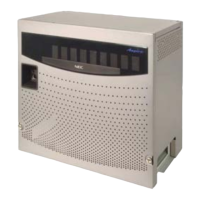Setting Up The Networking Feature
IP Networking
30 ◆ Networking
27 RX Gain 0-28 (-14~+14)
0 = -14 dbm
1 = -13 dbm
:
14 = 0 dbm
:
27 = 13 dbm
28 = 14 dbm
14
28 Audio Capability Priority 0:G711_PT
1:G723_PT
2:G729_PT
0
29 Echo Canceller ConÞg Type 0 = Auto
1 = Type 1
2 = Type 2
3 = Type 3
0
30 Echo Auto Gain Control 0 - 5 0
31 DTMF Relay Mode
In-band signaling is the way to send DTMF tone just
as audio (in band of the RTP packet). There is no other
message sent to the far end for the DTMF digits.
Therefore, if this is used with G.729 protocol, the
DTMF tone will not be received properly. At the level
G.729 compresses the audio, it affects the actual
DTMF tone and it can not be interpreted by the far
end. This is by the design of VoIP and there is no way
to correct it. If G.729 is used, then out-of-band signal-
ing is required when DTMF digits need to be sent over
the network.
Out-of-band signaling sends a special message to the
far end for the DTMF digits (out of band of the RTP
packet). The actual DTMF audio will be muted. There
are two signaling types - RFC2833 and H.245/VOIPU.
Both signaling types should work on every protocol
(G.729, G.711, etc.). RFC2833 must be selected in
order for DTMF digits to be sent over the network.
0 = Disable
1 = RFC2833
2 = VOIPU
2 84-06-10 :
VOIPU Setup
- DTMF
Behavior for
the card slot of
the VoIP card
to out of band
(an entry of
"2")
32 FAX Relay
Select "2" for FAX Relay to SLT (Program 15-03-
03:special), Trunk and networking.
Refer to Program 84-01-36 through 84-01-57 for FAX
Relay options.
0 = Disable
1 = Enable
2 = Each Port Mode
0
Item
No.
Item Input Data Default
Related
Program

